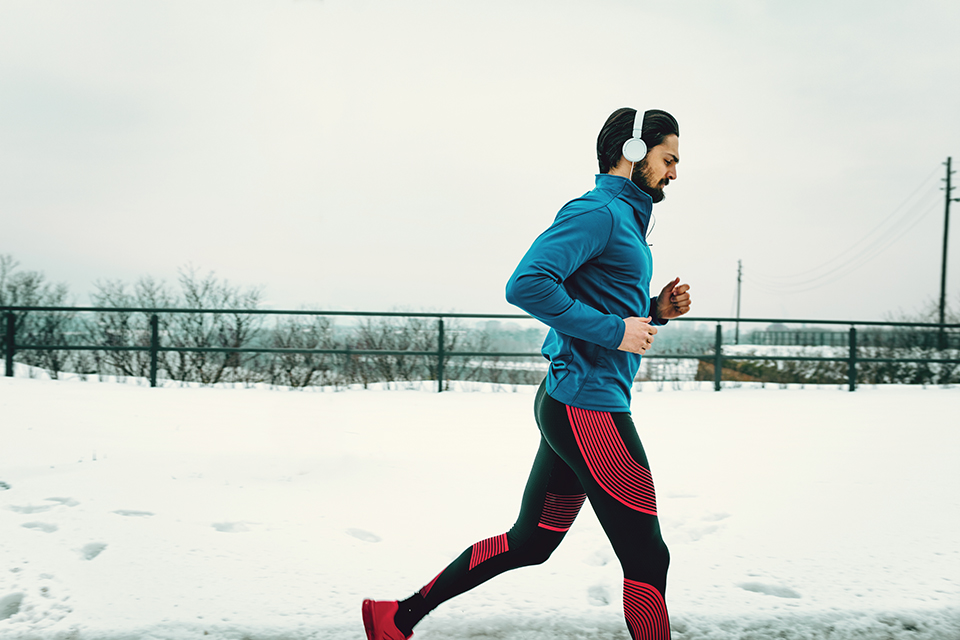Cold Weather Running and How it Affects the Body

As the winter months arrive, falling temperatures and fewer daylight hours can make it difficult to keep up with your workout or running routine. Staying motivated and getting adequately dressed for the cold can make even the most dedicated runners go into hibernation. While it may be tempting to swap your usual trail run for an indoor session on the treadmill, there are actually a few benefits to consider before taking your runs inside for the winter.
To understand how the cold weather can impact running performance, we asked Dr. David Di Paolo how cold weather affects our bodies during exercise, and what we can do to make the most of winter runs.
Longer Runs
Running in the cold can often feel easier due to a decreased cardiovascular strain on the body. A cool environment means your body doesn’t have to work as hard to get rid of extra heat produced during exercise, resulting in a lower heart rate. The body regulates temperature in warm environments both by sweating and by transporting the blood to the surface of the skin so it can release heat into the external environment.
According to Di Paolo, the body tries to lose heat in an already warm environment. There is less blood flowing to the heart, which then demands the heart to work harder to pump the blood to the rest of the body. With less stress on the heart, a cool environment allows for more efficient and longer runs.
Boost your Immunity
Exposure to the cold winter environment while running can lead to reduced immune function, making the body more vulnerable to sickness. Low intensity shivering, however, has been shown to increase immune response at certain exercise durations.
“Long-duration exercise, such as in marathon running, can temporarily reduce the number of immune cells circulating in the bloodstream, as documented in many studies in the ’80s and ’90s,” Di Paolo says.
During the strain of a long run, the body churns out the stress hormone cortisol, which suppresses immune function in large amounts. In order to receive the benefits of boosted immune function, Di paolo recommends doing 30 to 45 minutes of moderate running or exercise in the cold.
Count your calories
There are many studies that extra calories are burned while running in colder environments. While the shivering mechanism can result in an additional calorie burn, it is rarely experienced while running. In a cold environment, the shivering mechanism activates the muscles to secrete a hormone called irisin that stimulates the fat cells to produce heat. This allows both muscle and fat cells to be engaged in burning calories.
“Shivering does result in the burning of additional calories [up to 400 calories per hour], but if the runner begins jogging shortly after entering the cold environment, the additional calorie burn will be minimal, since there is a rapid rise in body temperature with running,” Di Paolo says.
Studies have shown that athletes tend to consume more calories after cold-weather exercise, which can easily offset any greater calorie burn that occurs from the shivering and exercising in the cold.
Know your symptoms
If you frequently exercise in cold weather, you’re probably already familiar with the symptoms of a runny nose and burning windpipe. These symptoms occur while running in the cold environment as breaths become faster and deeper. Di Paolo says the “skier’s nose” occurs as blood vessels in the nose dilate in order to warm and humidify air for the lungs.
The extra blood flow results in greater mucus production, which in turn can lead the nose to run. The burning sensation experienced in the windpipe however, is not from the freezing air, but from dry air. The humidity is less in cold weather, so when cold air is inhaled, it is heated and humidified by the nasal passages and throat. This donation of moisture can leave the nose and throat feeling scratchy and irritated, which results in the perception of burning.
Watch the Wind
One of the most important factors to consider while running in the cold is which direction the wind is blowing. Not only is running into the wind difficult, but it can be dangerous. As an outdoor run progresses and the body produces sweat, the effects of windchill can be more harmful. For cold, windy days, it is recommended that runners complete a “down and back” course, starting against the wind, and finishing with it behind.
“On windy, cold days, make sure the outer layer of clothing is wind-resistant but still breathable. Cover ears, hands and other exposed skin when the wind-chill factor dictates,” Di Paolo says.

Layer your clothing
Dressing in layers is the best way to prepare for the cold. As your workout progresses and your body warms up you can unzip or remove items to stay in the perfect temperature range.
Di Paolo recommends a synthetic, moisture-wicking layer next to the skin, and an outer layer that is wind-resistant, water-repellent and breathable. Inner layers of cotton should be avoided because they can retain sweat. Gloves and headbands should also be used to cover extremities and protect them from wind. When the workout is over, and your clothes are sweaty, it is important to get out of the cold and change clothes in order to protect the body from excessive heat loss.
In order to truly reap the training benefits from the challenges presented in the cold, it is important to listen to your body and know your limits. Be conservative with your workout routine, and know when to make adjustments to opt for a recovery or cross-training day to match dangerous weather conditions. Flexibility in your training plan can help you stay safe without feeling guilty about missing a workout.






